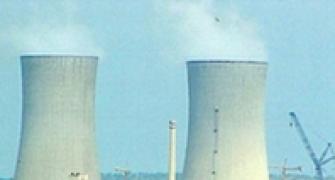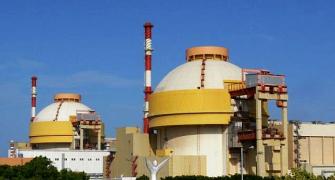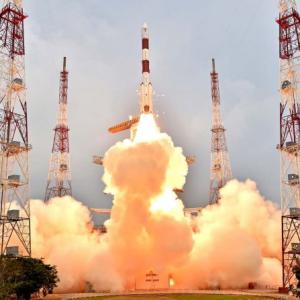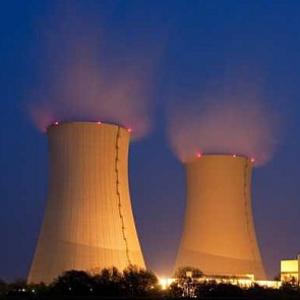While nuclear engineers cheer the KNPP's first full operation, on nine other sites which house atomic reactors, scientists spend sleepless nights, reveals Pallava Bagla.

At India's highly-guarded and walled atomic establishment, there are cheers in southern India, but tears in the western part of the country.
Much to cheer about at Kudankulam, as India's largest nuclear power park situated not far from the tip of India, Kanyakumari, is now operational.
The twin 1,000-megawatt atomic reactors have nuclear fission reaction running in them for the first time. The first unit started supplying electricity in 2013 and the second unit became operational last week and will start feeding electricity to the grid in a few weeks.
At the same time, some 2,000 km away, some grief and tears since the indigenously made Kakrapar Atomic Power Station in Gujarat remains shut for nearly four months after a leak in the nuclear island of the reactor forced an emergency shutdown of a fully operational plant.
The bigger headache for the Indian nuclear engineers is that even after several months of investigation, the exact reason why the 'leak' took place remains a mystery.
The usually mild mannered but vigilant nuclear watchdog of India -- the Atomic Energy Regulatory Board -- issued an ominous statement which said 'the incident of leak from a coolant channel at Kakrapar Atomic Power Station Unit 1 at an early stage of its life has raised some concerns.'
Kudankulam: The vanvas ends
At Kudankulam, which is not far from Lanka, the 14-year hiatus in starting the atomic reactors is almost akin to the 14-year vanvas or banishment for Lord Rama as recorded in the religious epic Ramayana.
The nuclear vanvas for Kudankulam ended on July 10, 2016 when the first sustained nuclear fission was attained in the second unit of the Russian-made nuclear reactors.
The construction for the first two units began in 2002 with the target to make it operational in five years. But it has taken almost three times that amount of time.
Time overruns on infrastructure projects prove to be very costly, especially since Tamil Nadu was woefully short of electricity.
The large reactors at Kudankulam have been delayed for various reasons -- there was considerable delay in supplying parts by Russian manufacturers and then just as the first unit was to become operational three years ago, an anti-nuclear agitation, in part initially fuelled by the government of Tamil Nadu, halted work at the almost ready atomic plants.
Today the two atomic reactors at Kudankulam have cost over Rs 22,000 crore, confirms S K Sharma, chairman-cum-managing director of the Nuclear Power Corporation of India Limited, the operator of the plant.
The 10-year delay escalated the cost of the reactors by almost Rs 9,000 crore -- a huge drain on the exchequer.
Local anti-nuclear activists like S P Udayakumar dub the reactors as 'unsafe' and call them a huge risk for the people living around the giant reactors.
The fairly affluent fisherfolk who inhabit the village closest to the nuclear reactors called Idinthakarai erupted against the establishment of the atomic reactors in their backyard and forced the plant authorities to delay the start of the reactors.
Countering the claims of the activists, the then chairman of the Atomic Energy Commission Srikumar Banerjee had called the Kudankulam reactors 'one of the safest in the world.'
In fact on the day both the reactors became operational, NPCIL issued a statement saying the Russian-made reactors are what are called 'Generation three-plus' atomic power plants, calling them 'state-of-the-art reactors that incorporate enhanced safety features ensuring the highest level of safety, in line with the current international standards. These have a combination of active safety systems as well as passive safety systems like passive heat removal system, hydrogen re-combiners, core catcher, hydro accumulators and quick boron injection system. This combination of multi-layered safety features ensures safety of the plant, public and environment.'
It was a combination of failures in outreach that seems to have fuelled the anti-nuclear agitation around the Kudankulam reactors. The plant authorities admitted that they failed to reach the village of Idinthakarai to convince them about the safety features of the plant.
In addition, just as the first unit of the Kudankulam plant was getting ready in 2011, the nuclear accident at Fukushima in Japan shook the world and left the largely Christian fishing community around Kudankulam in a heightened state of fear.
To add fuel to the fire, around the same time the NPCIL conducted a crucial test of a pressure relief valve for the giant reactor which can be likened to an ultra-big pressure cooker in the middle of the night. This involved dumping steam from the 1,000-MW reactor and the noise it made was heard as far away as 20 km.
Imagine the ruckus a tiny pressure cooker makes in the kitchen and everyone in the neighbourhood knows something is cooking, multiply this millions of times and that was the sound that shocked and rocked the residents.
No warning was issued to the locals and when it happened, they feared that, like the explosions at Fukushima, the atomic reactors at Kudankulam had exploded. Nothing of that sort had happened and it was only a controlled experiment that went wrong in outreach.
This agitation brought the all-powerful Department of Atomic Energy, the fountain head of India's nuclear weapons, down on to its knees.
It was really the fear of the unknown that fuelled the anti-nuclear agitation since, invariably, the nuclear plants are hidden behind high walls and guarded by armed forces. For some bizarre reason, nuclear engineers tend to work at their best efficiency at night.
Having created such a scare in the minds of the locals by their midnight test, the criticality or the start of the nuclear fission reaction for both Units 1 and 2 was triggered in darkness, when the fear factor is always higher.
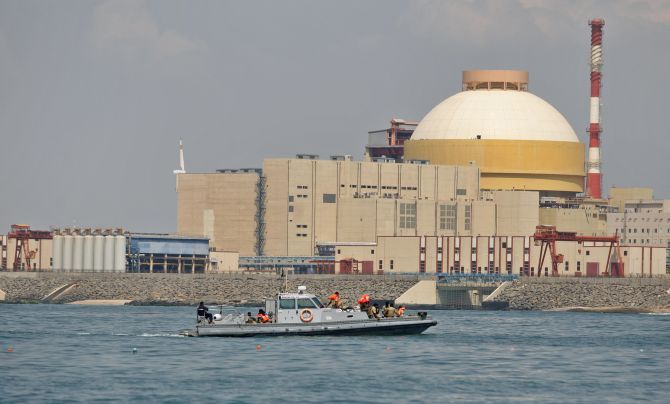
The latest milestone for Unit 2 was reached at 8.56 pm on Sunday last week. It seems by then the locals had developed some trust since no protests erupted in the aftermath.
Locals seem to have learnt a lasting lesson, but for some reason, the Indian atomic establishment continues to live like an ostrich, not internalising a simple fact that key milestones should preferably be undertaken during daylight hours.
If India has to establish 63,000 MW of nuclear plants by 2032 as is the government's plan, then winning the hearts and minds of people living around atomic reactors has to be undertaken at a war footing.
There is a suggestion that the AERB should make it mandatory that locals be sensitised on crucial tests and that such events should be undertaken only during daylight hours.
In a few weeks, the Kudankulam plant will start generating full 2,000 MW of power, helping the states of Tamil Nadu, Kerala, Karnataka and Puducherry bridge the power shortage. India now houses 22 reactors with a total installed capacity of 6,780 MW.
Now, the tears
The 220-MW Indian-made nuclear reactor located at Kakrapar in southern Gujarat failed on the morning of March 11, 2016. A leak developed and the automatic systems brought the reactor to a halt, even as the AERB asserted that 'there was no hazard to the operators and the public.'
No radioactivity leaked out beyond the permissible levels and no one suffered any radiation sickness.
Yet four months after the 'incident', the exact cause of the leak has not been deciphered. According to the AERB, preliminary investigation have revealed that 'the failed coolant channel is seen to have three cracks... the leaky coolant channel is yet to be removed from the reactor for detailed failure analysis and establishing the causes. Preparatory work for the removal of the channel from the reactor is currently in progress. Removal of this failed channel requires careful planning and preparedness as vital information on nature and causes of failure are not lost during the removal.'
Why should this one failed coolant channel worry India? India currently operates 17 similar reactors of the type that developed a leak at Kakrapar and together according to the AERB that would number some 5,000 coolant channels.
At this moment, it is hazardous to guess how the other coolant channels are faring. According to the AERB, as an immediate measure the sensitive leak detection systems installed at all operating atomic stations has been 'rechecked' by the NPCIL.
Yet the AERB raises a red flag when it says 'during the ongoing inspections at Kakrapar units, unusual indications of local corrosion spots was noticed on the coolant channels ... the AERB asked for inspection of coolant channels of other units to rule out the possibility of similar corrosion.'
After a suitable review, the AERB suggests that 'the presence of local corrosion spots is specific to Kakrapar units alone and no evidence of this phenomenon is seen in other reactors inspected so far.'
This is indeed worrying and the sooner the NPCIL completes these inspections the better it will be for India's ambitious nuclear programme.
Not mincing words, the AERB says 'exact reasons for the failure of Kakrapar Atomic Power Station Unit 1 can be established after completion of the failure analysis, which is expected to take considerable time.'
The redeeming fact is that in the over 400 years of combined reactor operating experience that India has accumulated while running 22 reactors since 1969 not a single death has occurred due to radiation exposure at India's nuclear power plants. Hopefully this record will remain unblemished.
Even as nuclear engineers cheer and celebrate the first full operation of India's largest nuclear power park at Kudankulam, on nine other sites which house atomic reactors atomic scientists spend sleepless nights checking the reliability of systems to avoid any mishaps.
Only nuclear sweat can wipe the tears to once again bring cheers at all Indian atomic units. Meanwhile, southern India eagerly awaits newly generated 'atomic electricity' with bated breath.

